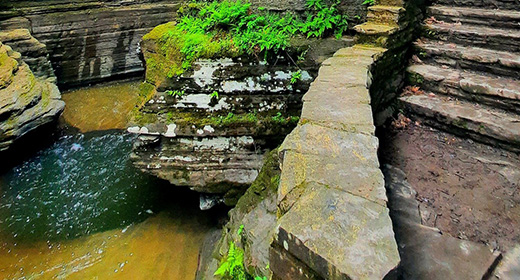by Ocean Robbins: On November 14, 1943, the 25-year-old assistant conductor for the New York Philharmonic Orchestra was relaxing as the orchestra finished preparations for a nationally broadcast concert at Carnegie Hall…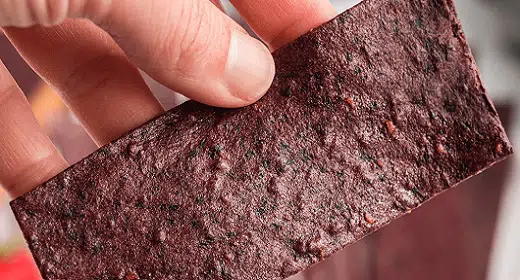
We are proud to announce a new partnership with John and Ocean Robbins and the Food Revolution to bring our readers Summits, Seminars and Masterclasses on health, nutrition and Earth-Conscious living.
Miss Your Chance to Attend for FREE!
His reverie was interrupted by an urgent message: The guest conductor, Bruno Walter, had just come down with a bad case of the flu and the regular conductor, Artur Rodziński, was unavailable. The assistant would have to conduct the concert with zero rehearsal time.
Luckily, that young fellow (also known as Leonard Bernstein) had spent hundreds of hours preparing in his mind to conduct the challenging program. After just a few minutes chat with the ailing Walter, Bernstein took up the baton and led the Philharmonic in a performance that the New York Times described on the following day’s front page as a “warm, friendly triumph.” After taking full advantage of that big unexpected break, Bernstein went on to a career as the most famous and revered American conductor of his time.
In 1989, Bernstein admitted that he had fantasized about such a moment many times, but never thought it would actually happen. The moral of the story, from my perspective, is that had he not considered the possibility enough to prepare for it, Bernstein would not have aced the concert — and the world might never have known about one of history’s greatest conductors.
While you may not be plucked from anonymity to conduct at Carnegie Hall, you may one day face a different kind of challenge that you can choose to prepare for ahead of time: an emergency that disrupts the food supply.
Why Preparing for Emergencies Is Important
The COVID-19 pandemic has taught us that society-wide emergencies are possible, and that preparing for the next one is a prudent strategy. Whether the next one will be a weather event, an earthquake, a civic disruption, or another public health crisis, we can make sure we’re as prepared as possible in terms of having a supply of necessities in case we can’t get to a store — or in the case of panic buying or widespread supply chain disruption.
Being prepared is important for a lot of reasons.
- Having enough food and water to last a few days or weeks is a form of security for yourself and your family.
- You can avoid long lines and panic buying at stores when demand tends to overwhelm supply.
- If the emergency calls for an evacuation rather than hunkering down in place, you’ll be ready to go.
- Knowing you’re ready for an emergency can ease the anxiety and stress that can arise during an emergency.
- Arguably, those are all self-centered reasons to prepare for emergencies, so the fifth reason is perhaps the most compelling. By being prepared, you can also become a helper rather than another person in need of help.
Peruse the online world of preppers and survivalists, though, and you could be forgiven for thinking that prepping and eating plant-based are mutually exclusive. From the bunkers full of canned spam and jerky to the backyard chickens and pigs, most preppers prioritize animal products over plants. The plant foods that do make it into the prepper repertoire are often highly processed so that they can provide lots of calories and extended shelf life — two useful qualities in an emergency of unknown duration.
So, if you want to prepare your household for a few days to a few weeks of emergency living, must you sacrifice healthy eating? Do you have to consume processed foods and animal products, or can you eat in alignment with your long-term health goals even when emergencies arise? (Spoiler alert: You can do the latter!)
If so, what do you need? Do you have to purchase expensive survival kits, or can you prep any supplies yourself?
Emergencies Are More Common Than You Might Think
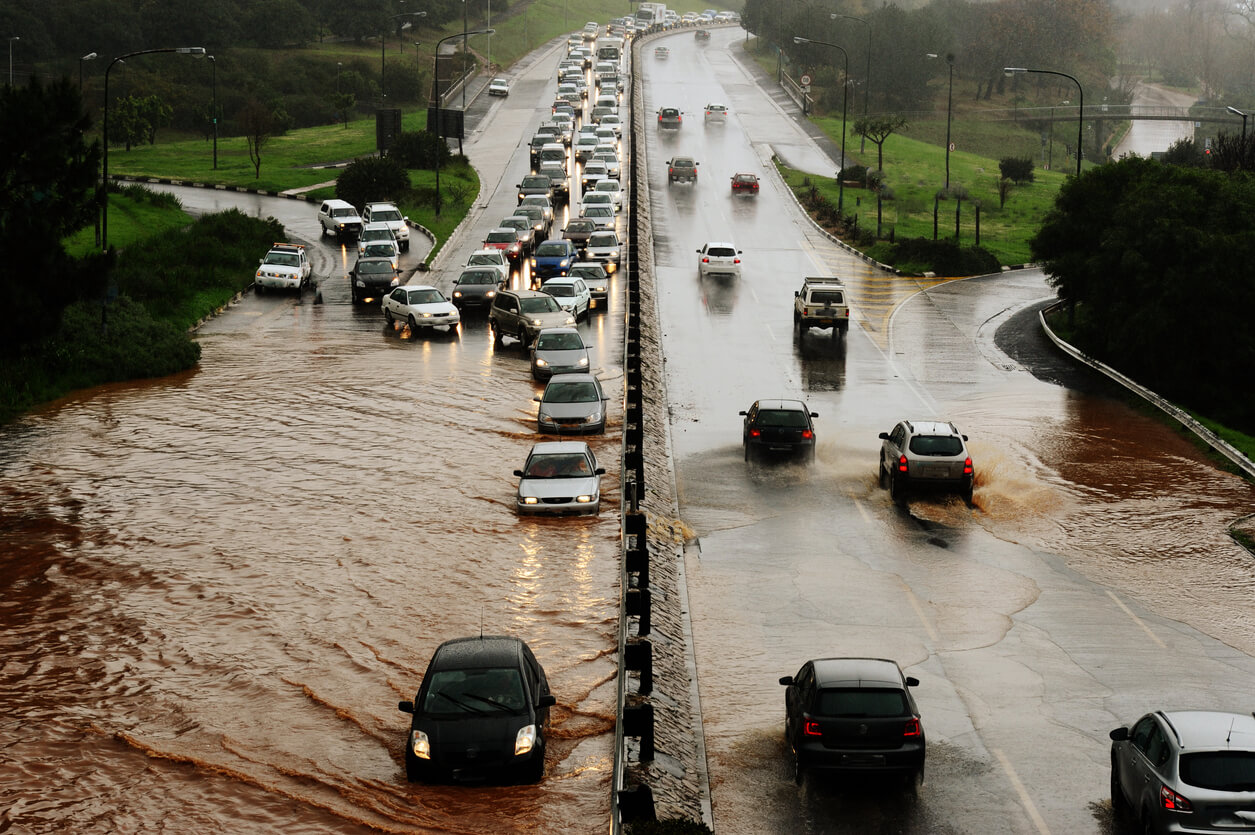
If you’ve spent your whole life in environments where the food and energy supplies are stable and reliable and where civil order more or less prevails, you may think that emergency preparation is unnecessary, or much more trouble than it’s worth. After all, you haven’t needed to do it so far, so why start now?
The short answer is, if a disaster hasn’t affected you yet then you’ve been lucky.
Natural and human-made disasters disrupt the lives of millions of people. On average, 218 million people worldwide are affected by some major emergency or disaster each year, with 68,000 people killed. In 2020 alone, the 22 biggest natural disasters in the US caused at least $95 billion in damages to property and infrastructure. With climate change, sadly, these numbers are projected to increase dramatically in the decades to come.
If a disaster strikes, being prepared can make the difference between life and death. If you’ve got your basic needs taken care of, you might get to be a source of strength and support for others in a time of crisis. Being more resilient also means you could be in a stronger position to start picking up the pieces in the aftermath.
Building Your Emergency Kit and Go-bag

Preparing for an emergency involves planning, first. What food, clothing, medicines, gear, fuel, and other supplies do you need to stay alive and healthy — whether you need to evacuate (to an unknown location, for an unknown period of time) or hunker down in place?
Before we get into the details, I want to detour for a moment and talk about mindset. I’m not advocating preparing for the worst in a fearful, paranoid, or self-centered way. Rather, thoughtful preparation can actually open our hearts and make us more loving, grateful, and generous.
Just thinking about the bare minimum we need to survive can make us aware of — and therefore grateful for — all the “extras” in our lives. If you can get by with two pairs of pants, then the additional 12 pairs in your closet (in different colors and styles) are all luxuries. It’s easy to get used to the things we have, especially in a society that constantly prods us to seek more. Reminding ourselves on a regular basis that we have more than we need can help break the spell of advertising and focus our attention on the good things we already have.
Also, just having emergency supplies on hand — bringing the possibility of disaster into our awareness on a regular basis — might help us to feel grateful for every day that is “normal.” This can lead us to become more generous with others, especially those in parts of the world where disasters do strike. “There but for fortune go you or I,” sang Phil Ochs in his song about not taking things for granted.
With these mindsets activated, let’s look at what emergency preparation might entail.
Your Shelter-in-Place Kit
In the event of a weather emergency, you should be prepared to keep your family safe and nourished for at least three days without any outside help. The US government’s emergency preparation website, Ready.gov, suggests the following items as the bare minimum for your 72-hour emergency kit:
- One gallon of drinking water per person, per day
- Three-day supply of non-perishable food
- Battery-powered (or hand-crank) radio and an NOAA weather radio
- Flashlight and extra batteries
- First aid kit
- Whistle (to signal for help)
- Plastic sheeting and duct tape (in case of storm damage to your home)
- Dust masks (in case structural damage to your home contaminates the air)
- Moist towelettes, garbage bags, and plastic ties (a makeshift toilet, in case of a plumbing or sewage disruption)
- Wrench or pliers (to turn off gas and water lines)
- Manual can opener
- Local maps (paper, not digital, in case the grid goes down)
- Cell phone with chargers and backup battery
Here’s another written guide that explains the rationale behind being prepared to survive on your own for 72 hours.
Use your judgment in putting your kit together. If you live in a rural area, you may be able to use the outdoors as your toilet. Or if you are within walking distance of a river, pond, or lake, then you may want to have water purification supplies (bleach, iodine tablets, and/or a portable filtration system) at the ready instead of bottled water. If your household includes companion animals, then include their necessities as well (food, meds, and so on).
Your Go-Bag

Some disasters necessitate leaving home rather than hunkering in place. If you’ve seen footage of bumper-to-bumper highway traffic consisting of tens of thousands of citizens fleeing an approaching storm or wildfire, you’ll appreciate that simply hopping into your vehicle with a quarter tank of gas and a GPS phone app may not be enough to get you and your family to safety (to say nothing of security and comfort).
That’s why creating a pre-packed bag with a full complement of emergency supplies is perhaps the most important action you can take in response to this article. It may be the one thing that is worth spending time and energy on, even if you never need it (which I hope will be the case).
You can find thousands of examples of go-bags online (they’re a popular blog post topic for preppers and survivalists), and many of them will give you ideas for what you can put in yours. Here’s a good one, including photos of the various components. Don’t just copy someone else’s because it’s got cool gear, though. Customize your go-bag to meet the needs of the people (and any non-human family members) it serves.
Assemble the items first, then choose a bag that will accommodate those items. You can use an old backpack or duffel bag. Stay away from bags that you can transport only by using their wheels; that’s fine for airports, but if you do need to get out of town in a hurry, you won’t be able to depend on paved or tiled surfaces.
If you spend a lot of time in your car or at an office, you may want to keep an additional bag handy in case an emergency strikes and you can’t easily get home.
A Food Stash to Prepare for Emergencies
Building up your emergency food stash doesn’t have to turn into a frantic, expensive, all-consuming activity. Sure, you can go online, click a button, and quickly spend three grand on a kit consisting of 2,700 meals that will stay edible (depending on your definition of the word) and safe for the next quarter-century. (There are definitely movies that can motivate you to make an impulse purchase like that: The Day After Tomorrow and 2012, anyone?)
Start Slowly
Instead, I recommend starting slowly. Rather than instantly amassing a year’s, month’s, or even a week’s worth of food for a family, start with that 72-hour supply. That time frame is a rough estimate of how long it might take emergency personnel to reach you if you’re sheltering in place after a particularly calamitous storm or earthquake.
You can add to your supply over time, in an intentional fashion, so your stash can feed you and your family for longer and longer periods. This way, you can avoid a giant upfront purchase and buy items when they’re on sale. Also, you won’t contribute to current shortages if you stagger your purchases — you probably don’t want to be the reason that no one for 50 miles can find a single serving of organic applesauce.
Create a Larger Cache
If you’re plant-based and/or vegan, I recommend creating a larger cache so you can continue to eat plant-based after rescue. Emergency shelters are probably not going to cater to specific diets in a situation where just delivering calories is their top priority.
Prepare for No Power
One thing to expect during a disaster is loss of electricity. If you don’t already live off-grid, start thinking about what you would need if you didn’t have power for a week or two. Regarding food, you’d probably want a way to keep some items cold, even in the heat of summer. Keep some coolers on hand for non-electric refrigeration, and also some ice packs frozen and ready to add to your fridge or a cooler.
If you do have a power outage, a well-insulated fridge or chest freezer can maintain food-safe temperatures for a couple of days if you keep the door closed. When your power is down and your fridge is full of fresh produce, that’s not the time to stand in front of the open door trying to decide between a carrot and a celery stalk!
Manage Your Inventory
Storing a lot of food will require some inventory management if you want to make sure that everything you have is eaten before its “best by” date. While these dates can be arbitrary marketing ploys, there is a limit to how long you’re going to be able to enjoy powdered black bean dip from the Carter administration.
Keep your stash up to date by maintaining an inventory, so you can constantly rotate out food whose biological clock is ticking loudly. There’s no need to waste it; if you’ve been fortunate enough not to need to consume your emergency food supply before it’s about to expire, go ahead and cook with it. Add those items to your shopping list, so you can be sure they’re replenished, and your supply stays full and fresh.
Water Is Life

Humans can survive for weeks without food, but will succumb to dehydration after just a few days without water. Human bodies are about two-thirds water, and while some of the water we consume stays inside us, much of it passes right through, cleansing as it goes. (This may explain why large crowds in sports stadiums will repeatedly chant, “We’re number one!” — a terrible joke that I stole and can’t remember from where.) Water isn’t just important for drinking, either; you’ll also need to cook with it if your food stash consists of dehydrated foods or dried grains or pulses.
As we’ve seen, you should keep one gallon of water per person, per day on hand, which means you need to think about how you’re going to collect and store all that water ahead of time. You could just buy plastic water bottles or gallon jugs, but plastic can degrade over time, leaching harmful chemicals into the water it contains. Especially if the water storage area gets hot or might be exposed to sunlight at any point, I’d recommend finding a different storage medium. That said, in an emergency pretty much any water is better than no water.
Ideally, you would store your water in a ceramic water dispenser or glass bottles. If that’s not possible, there are plastic water barrels that don’t contain BPA (a chemical of concern) that can hold a lot of water — here’s a 55-gallon drum.
Keeping Water Clean
If you have a supply of water that doesn’t depend on the power grid to get to you (a well with a hand pump, battery system, or generator, a nearby body of water, or your own water storage like a cistern or rain barrel, you’ll need a way to filter that water to make it safe to drink. Since the power will likely be out, you’ll want a gravity filtration system such as the Berkey line, which is designed to eliminate the bacteria that could make you sick.
If the power is out and you don’t have a natural gas or propane stove in your kitchen, you have several outdoor options. First of all, you can cook with a camping stove. The ones you can buy at camping stores often require their own proprietary fuel canisters, so make sure you have enough fuel on hand to boil water for several days. Some camp stove manufacturers, like Coleman, also make adapters that allow you to attach a standard 20-gallon propane tank, which can last for weeks or months depending on use.
Another stove design that’s becoming increasingly popular is the rocket stove, which uses small quantities of fuel (typically twigs and branches) to channel an impressive amount of heat into a small area. In a pinch, even a fire in a fire pit can work to heat water and cook food.
Building a Survival Garden
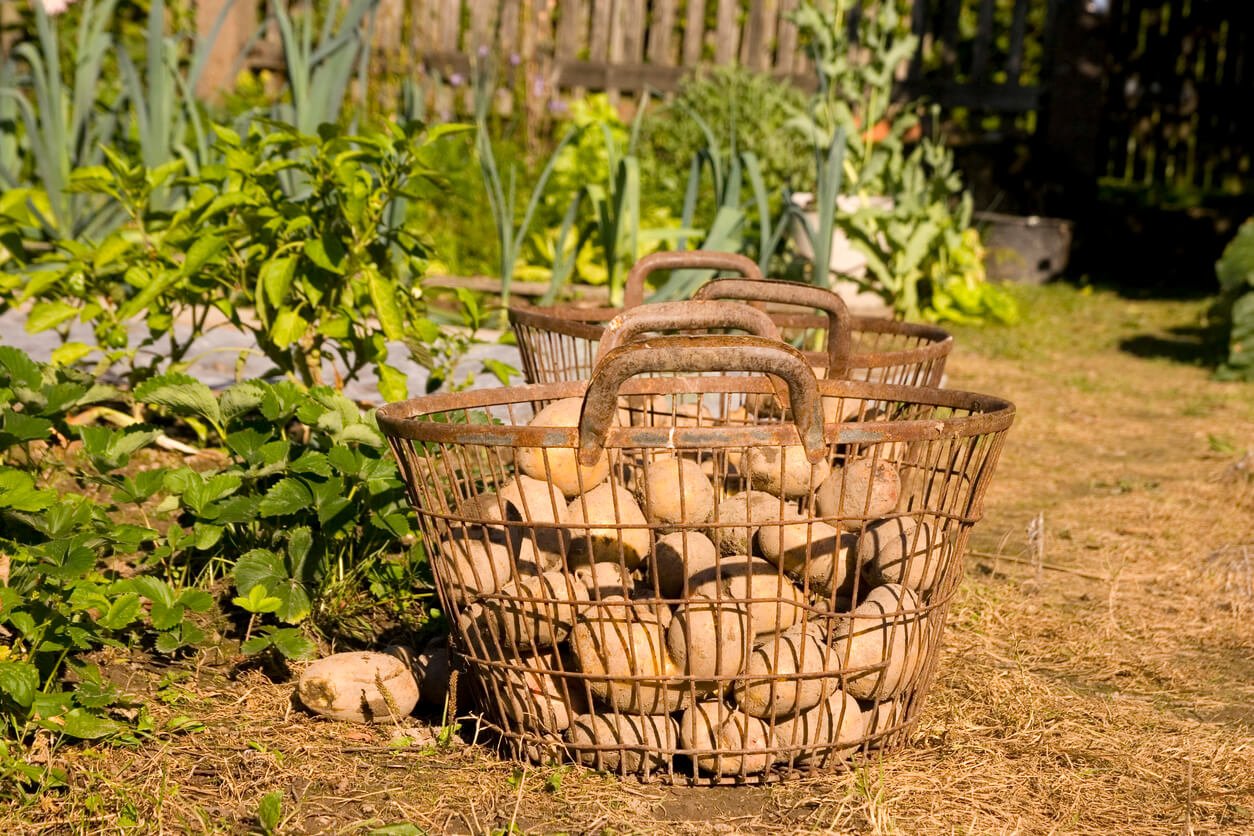
As I’ve said, prepping for disaster doesn’t have to be a paranoid, defensive endeavor. One way you can prep that can enhance your life even in the absence of an emergency is to build a survival garden.
It won’t necessarily help if you need to evacuate (“Honey, grab the carrot bed and stick it in the back of the Prius”), but it can provide fresh and safe nourishment for shelter-in-place scenarios. Survival gardens can buffer us from supply chain disruptions caused not just by natural disasters, but also by transportation problems, labor shortages, and economic upheavals.
Another nice thing about a garden is that it’s pretty much impossible to grow nutrient-poor processed foods. Instead, you can support your family’s health with fresh fruits, vegetables, beans, grains, and herbs. If, when you plan your garden, you think in terms of emergency supplementation, you’ll be more likely to choose crops and varieties that you like, and in sufficient quantities for the entire family.
What to Grow
While hobbyist gardeners often focus on high-nutrient, low-calorie foods (tomatoes, eggplant, broccoli, okra, and so on), prepping gardeners also add calorie-rich crops like grains, corn, squash, oily seeds (like sunflower), and tubers such as potatoes, carrots, sweet potatoes, beets, and parsnips. Depending on your climate, some root vegetables can overwinter in the soil or can last for months in a root cellar or similar cool environment. When you combine these crops with various methods of food preservation such as canning, dehydration, and fermentation, you can have a robust source of delicious, health-promoting, home-grown calories available for emergency use.
In addition to the crops already mentioned, you can grow the following as part of a survival garden: onions, garlic, cabbages and other cruciferous vegetables, apples, citrus fruits (some dwarf lemon trees and kumquats can provide fruit when grown indoors in containers), melons, and herbs.
Speaking of herbs (which are often easy to grow because their pungent aromas serve as pest repellents), you can also plant medicinal herbs to further support your health in times of uncertainty. Science is increasingly validating folk remedies that include herbs such as lavender, chamomile, rosemary, sage, thyme, mint, and oregano. For these and other herbs, you don’t need fancy equipment; you can simply boil the leaves and make yummy and healthful teas.
For more on how to get started building a food garden, check out this comprehensive article.
The Plant-Based Emergency Pantry
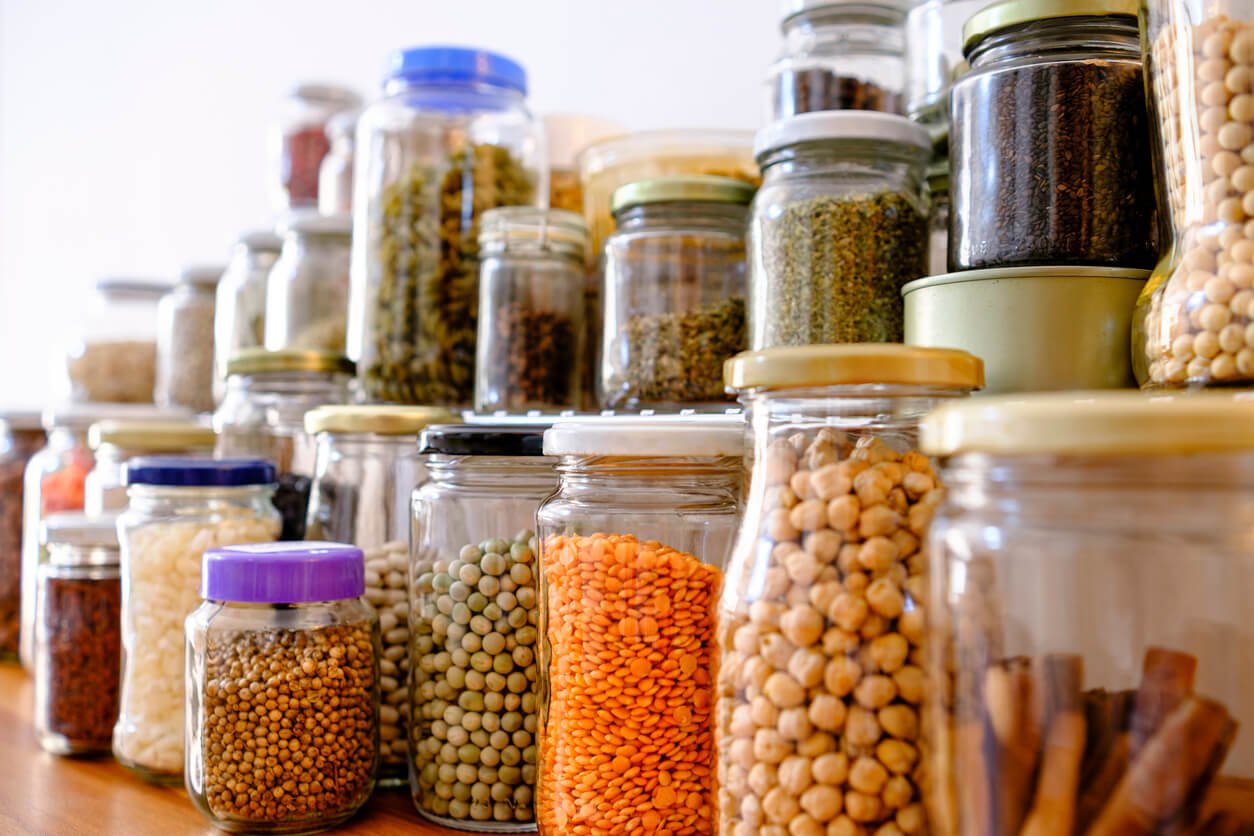
If you have a chest freezer and a generator (or solar panels with a battery), you can stock up on lots of food like frozen fruits and vegetables, bulk grains, nuts, and seeds. If that’s not the case for you, you can still put together a delicious and nutritious plant-based emergency pantry without converting half of your home into a walk-in freezer.
Pre-Made Meals
There are two ways to go here: pre-made meals and DIY emergency food. If you want to get started with the least fuss and effort, buying a case of pre-made plant-based meals can be a smart (though possibly expensive) strategy. These meals sure are convenient: just place and receive your order, store it in a pest-proof spot, and draw a giant checkmark on that to-do list item.
I’m not talking about 1,200 cans of SPAM, either. You can now buy pretty healthy, premade meals with a long shelf life. One brand to consider is Leafside, which provides nutrient-dense freeze-dried meals that don’t require any refrigeration. All you do is add hot water to reconstitute, then eat. These meals are aligned with Michael Greger, MD’s “Daily Dozen” (his recommended list of types of food to eat every day). Leafside also wins the coveted Food Revolution Network team member seal of approval (which is to say, AnnMarie really likes it).
Another option comes from Food for the Sole, which sells dehydrated vegan backpacking food that is also great for an emergency stash. This company sells individual servings as well as variety packs. Harmony House also sells some nutritious and convenient emergency (and camping) food supplies here.
Finally, plant-based eaters who are also gluten-free may want to check out NorthWest Fork’s Gluten-Free 30-Day Food Supply. These meals are also GMO-free and kosher, so they pretty much tick all the boxes. Six-month and 12-month kits are also available. For a more short-term cache, Good To-Go’s 5-Day Emergency Food Kit is a solid gluten-free option.
Homemade/DIY Emergency Food

For all their convenience, commercially premade meals can be pricey. Add in all the packaging and shipping costs (to you and to the environment), and you may not want to rely solely on pre-made meals for your emergency stash. Putting together your own disaster rations is more economical and, I would argue, worth the effort.
So, what might you find in a whole foods, plant-based pantry that’s ready for an emergency? Well, largely the same things you’d find in an ordinary WFPB pantry (just in greater quantities). Provided you have room to store everything, this can save time and fuel as you won’t have to replenish your stocks every week.
Fresh Produce
Consider making non-refrigerated produce a staple of your pantry and diet. Types of produce that can last a long time on a counter or in a pantry include winter squash, sweet potatoes and other storage veggies, potatoes, garlic, onions, apples, and citrus fruits.
Dried Goods
Pantry essentials and dried goods that don’t need to be refrigerated include whole grains like organic oats, quinoa, and brown rice, dried beans and lentils, whole grain and legume pastas, nut and seed butters, granola, tea, whole coffee beans (with a manual grinder), your favorite spices and dried herbs, and organic apple cider vinegar.
Canned Foods
Canned and jarred foods can also be critical components of an emergency pantry. Make sure the cans are BPA-free and undented. Canned items can include beans, coconut milk (definitely not essential, but a rich source of calories that can make some soups and stews taste rich and special), tomato products, and applesauce. If you have canning equipment and supplies you can also stockpile a lot of fruits and garden produce, whether from your backyard or a local farm.
Liquids
You may also want other liquids, in addition to the water that we already talked about. (You do have enough water set aside, right?) Shelf-stable plant-based milk and milk concentrates such as soy, hemp, oat, coconut, flax, rice, and macadamia can be used for baking and on cereals and granolas. Veggie broth and stock can add flavor to soups, stews, and stir-fries.
Snacks
Don’t forget about snacks! Not only can they be concentrated sources of calories, but they can also cheer you up if you’re down. If an emergency requires lots of your attention and effort (for example, to clear away debris or take care of others), you may not have the time, energy, or inclination to cook. In this case, a snack can provide you with energy without requiring you to expend any to make it. Plant-based snacks could include granola bars, energy bites and protein bars, dried fruit, fruit leathers and rollups, seasoned crunchy chickpeas, and products by Mary’s Gone Crackers.
Prioritize Refrigerated and Frozen Foods
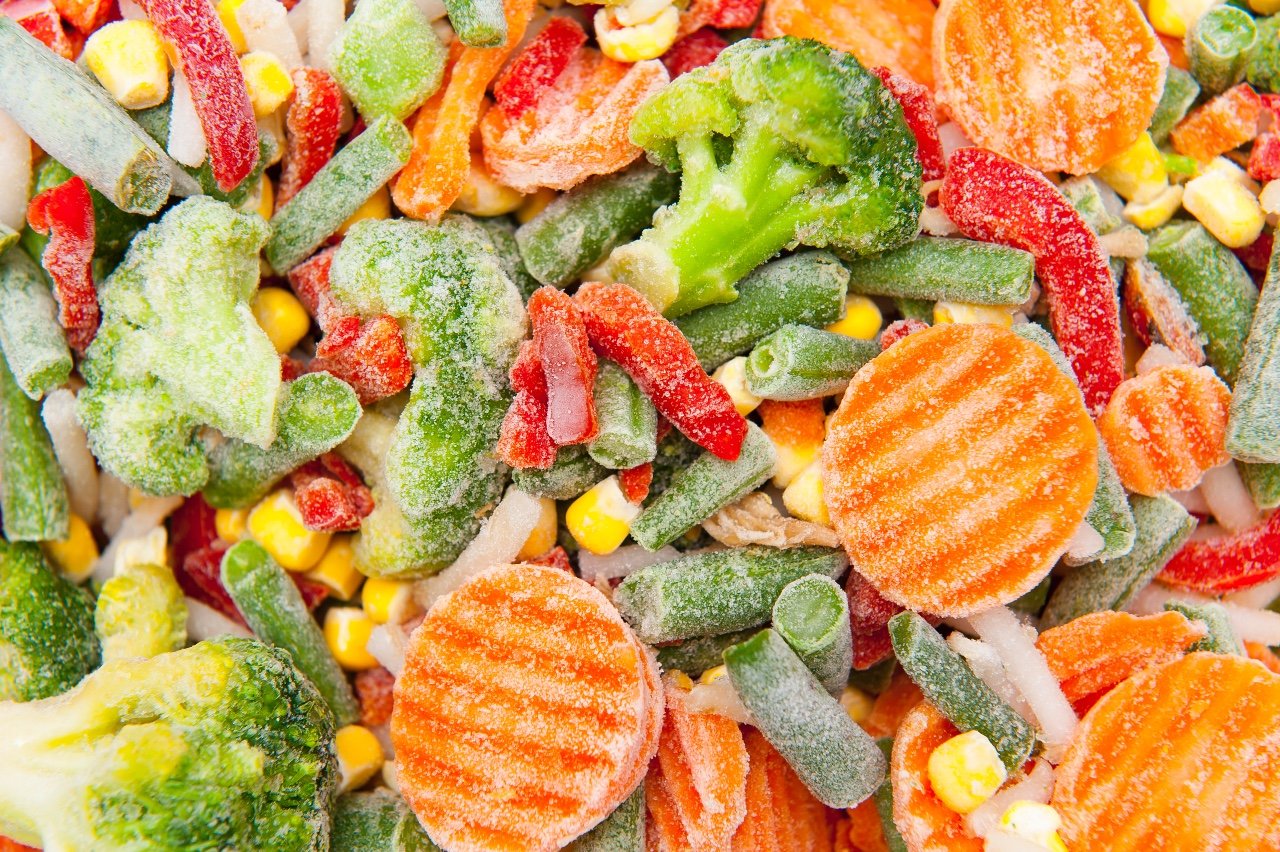
This may seem obvious, but in an emergency you may be too overwhelmed to think straight, so I’ll say it now: if you lose power and are sheltering in place, use up perishables first (as long as you can do so safely).
If you have a good amount of freezer space, part of your healthy eating routine may already include batch cooking and freezing. If so, well done! Most frozen food will keep well in the refrigerator for a while after the power goes out. You can extend that time considerably if you add cold packs, ice, or other frozen items to the refrigerated compartment. If you keep the door of a good-sized and solidly packed freezer closed, expect it to stay functionally frozen for 24–48 hours sans electricity. Here’s a “better safe than sorry” guide to food safety in the absence of power.
Another item in your emergency kit could be a fridge/freezer thermometer, so you can monitor temperatures to make sure the fresh produce and cooked food hasn’t started to grow harmful bacteria. For optimal function, your freezer temperature should not exceed 0°F, while the temperature of your refrigerator should stay at or below 40°F. Higher temperatures can still be OK, but will reduce storage longevity. Prolong the life of your refrigerated and frozen food by keeping the doors closed. Plan ahead for what you want to take out, and be quick about it.
What to Use Up First
If you have the ability to cook, start with the fresh veggies in your kitchen. You can easily make a soup, stir-fry, or stew. You could also grill veggies on an outdoor grill. Next, throw together an impromptu fruit or green salad. After that, prepare those frozen veggie burgers and frozen meals.
If fridge space is at a premium, you can remove any nuts and seeds and store them at room temperature (as they aren’t as perishable as the fruits and veggies). Unless you’re in extremely hot conditions, you’ll still be able to use the nuts and seeds for a while. Move them to a dark location, as cool as possible, to help them last.
On the other hand, the more mass of food you have in a fridge or freezer, the longer the whole box will stay cold. This is because solid and liquid foods have higher specific heats than air, meaning that it takes more heat to change the temperature of a bag of walnuts (for example) than the air it displaces.
Are you ready to roll up your sleeves and begin building your emergency food stores? If you want to flex your DIY muscles now — so your loved ones will thank you later — we’ve got some recipes below to get you started.
Healthy Emergency Preparedness Recipes
While you may need to buy some of the supplies you’ll want to have on hand, you can also prepare quite a bit of your own emergency food, from dehydrating individual fruits, to making your own nut or seed butter, to making a large family meal and freezing it for future use.
Use this Dehydrated Mixed Berry and Banana Fruit Snacks recipe as a template to make a variety of fruit leather snacks that store easily and for long periods of time. Make Super Seedy Granola and Cashew Walnut Butter for seedy and nutty snacks that provide long-lasting energy thanks to their perfect blend of complex carbohydrates, plant protein, and healthy fats. Create ready-to-eat meals for the whole family that can be frozen, thawed, and consumed during times of emergency. Of course, our hope for you is that you’ll never encounter an emergency and can simply continue to enjoy these recipes as a part of your everyday lifestyle!
1. Dehydrated Mixed Berry and Banana Fruit Snacks

Fruit leather is not only tasty but also functional. First, it’s a nourishing snack thanks to its high antioxidant content and natural sugars, which can also provide extra energy during emergencies. Second, it can store well for up to six months, making it a good choice to stock your plant-based emergency pantry. Third, it’s easy to store since it’s flat, doesn’t take up much space, and doesn’t need to be refrigerated. Use this recipe — we’ve included both dehydrator and oven directions — as a template to make a variety of fruit leathers like kiwi banana, mango pineapple, or apple pear.
2. Super Seedy Granola
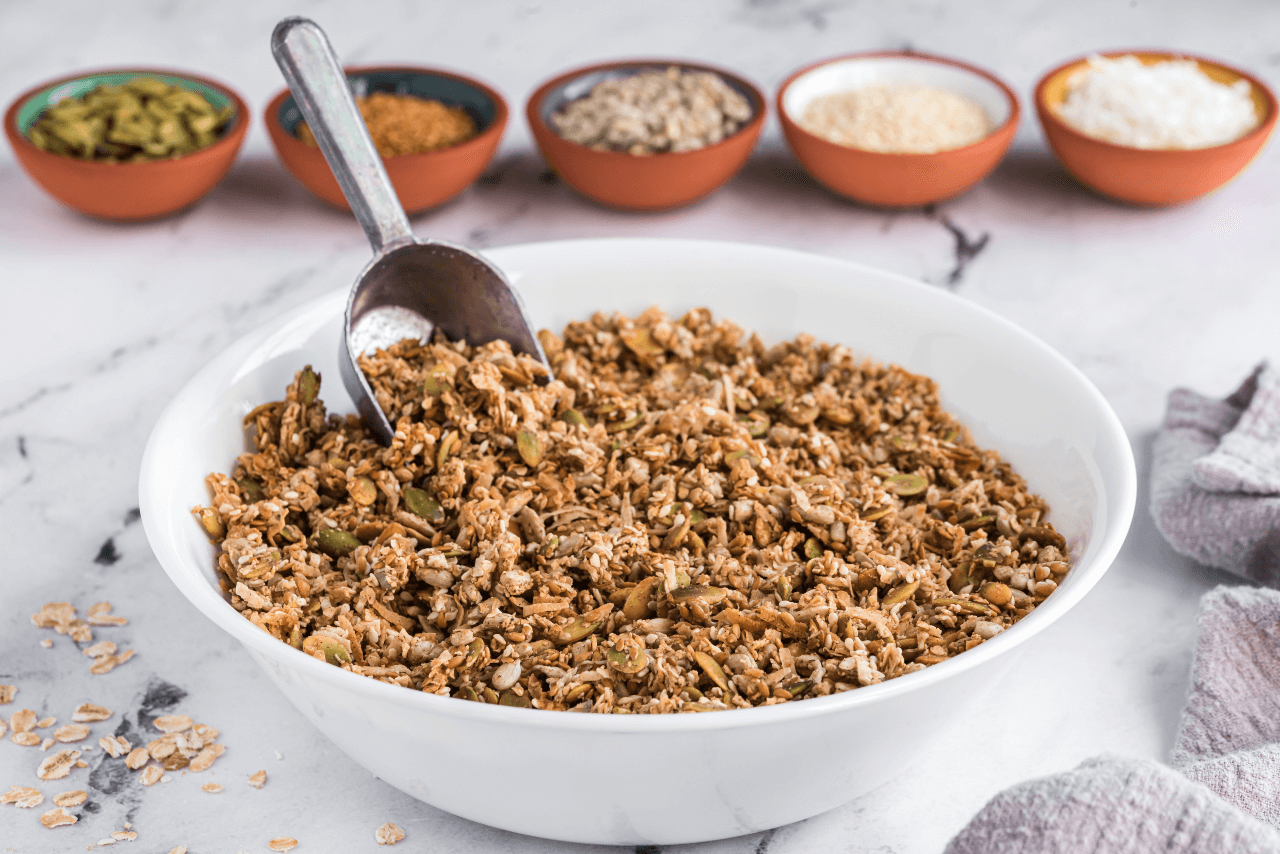
In the case of a long-term emergency (which we hope you’ll never experience), it could be helpful to have some snacks on hand that provide sustainable energy and include a little carbohydrate, a little protein, and a little fat — all from plants, of course. Super Seedy Granola (made with, you guessed it, seeds) fits the bill perfectly. Make it ahead of time and store it in the refrigerator for up to one month or the freezer for up to three months, so it’s ready to go when you need it.
3. Cashew Walnut Butter
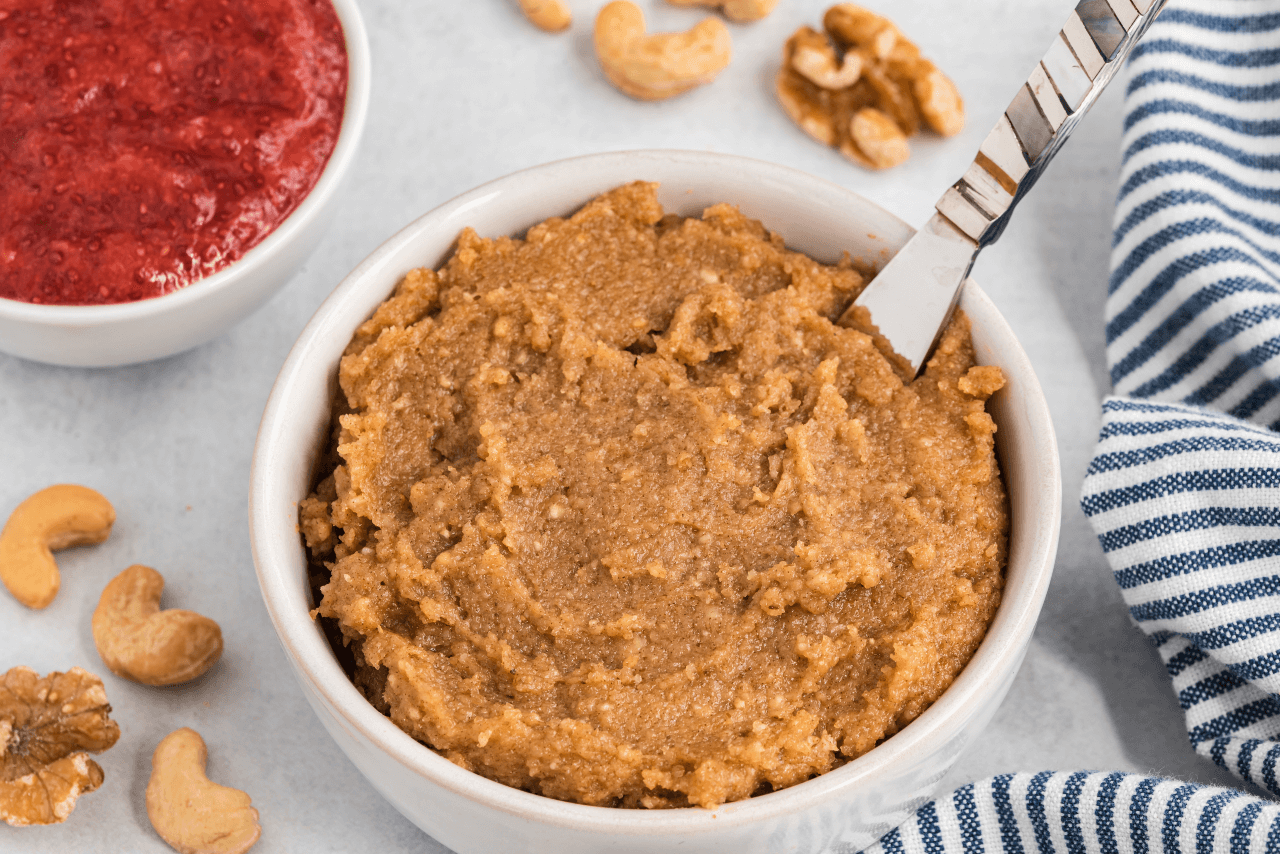
Nut and seed butters are a good source of protein and healthy fats, which are essential nutrients. This is especially important during times when it might not be easy to find cooked plant protein sources like beans, lentils, and tofu. Make a batch and store it in the refrigerator for up to one month or the freezer for up to three months. You’ll be happy (and relieved) to have it on hand if an emergency arises.
4. One-Pot Burrito Rice
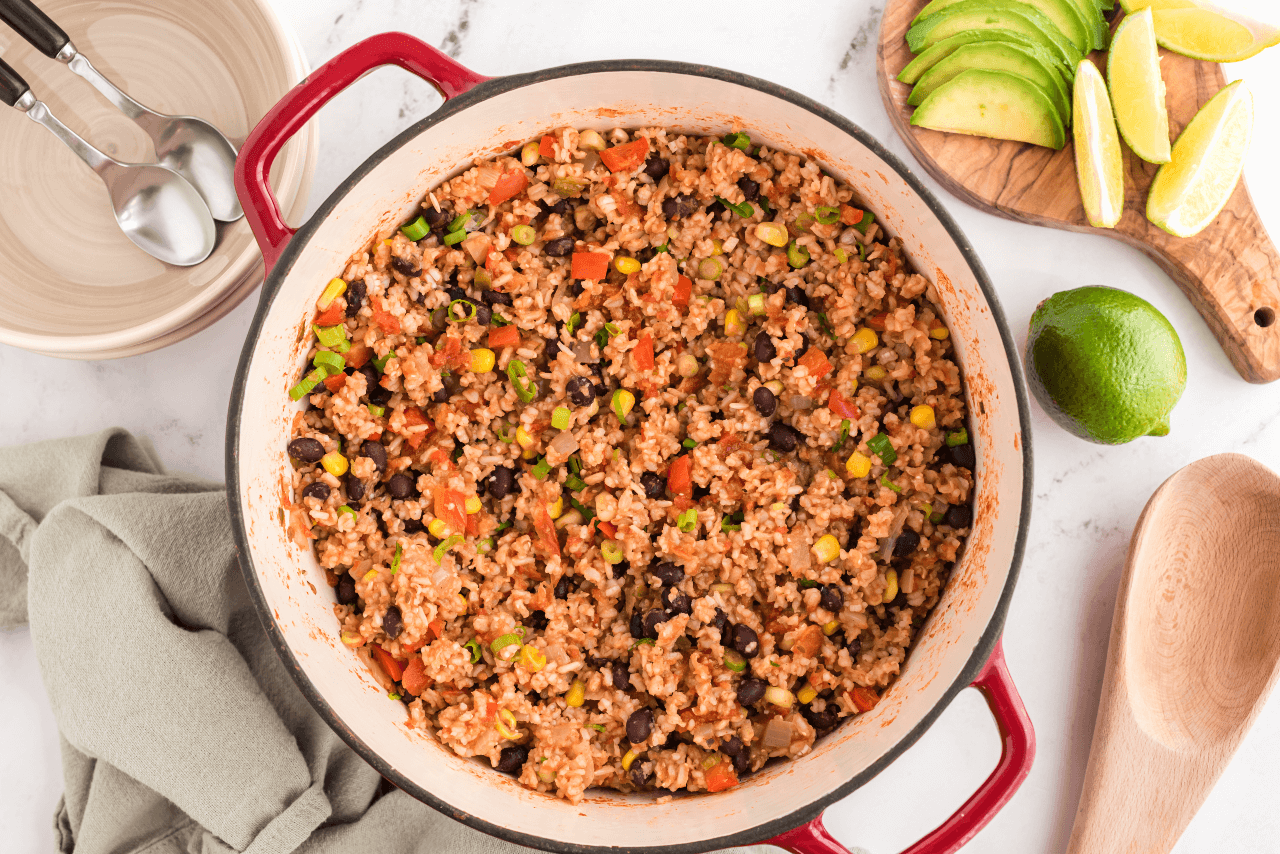
You might consider making a single, large, nutrient-packed meal and storing it in the freezer for shelter-in-place events. One-Pot Burrito Rice contains whole grains, beans, veggies, and spices, all of which can help to fuel you and your family during an emergency. Don’t worry about the toppings or garnishes — they can add more flavor and nutrition if you have them on hand, but the recipe is still delicious without them.
5. Hearty and Healing Lentil Burgers
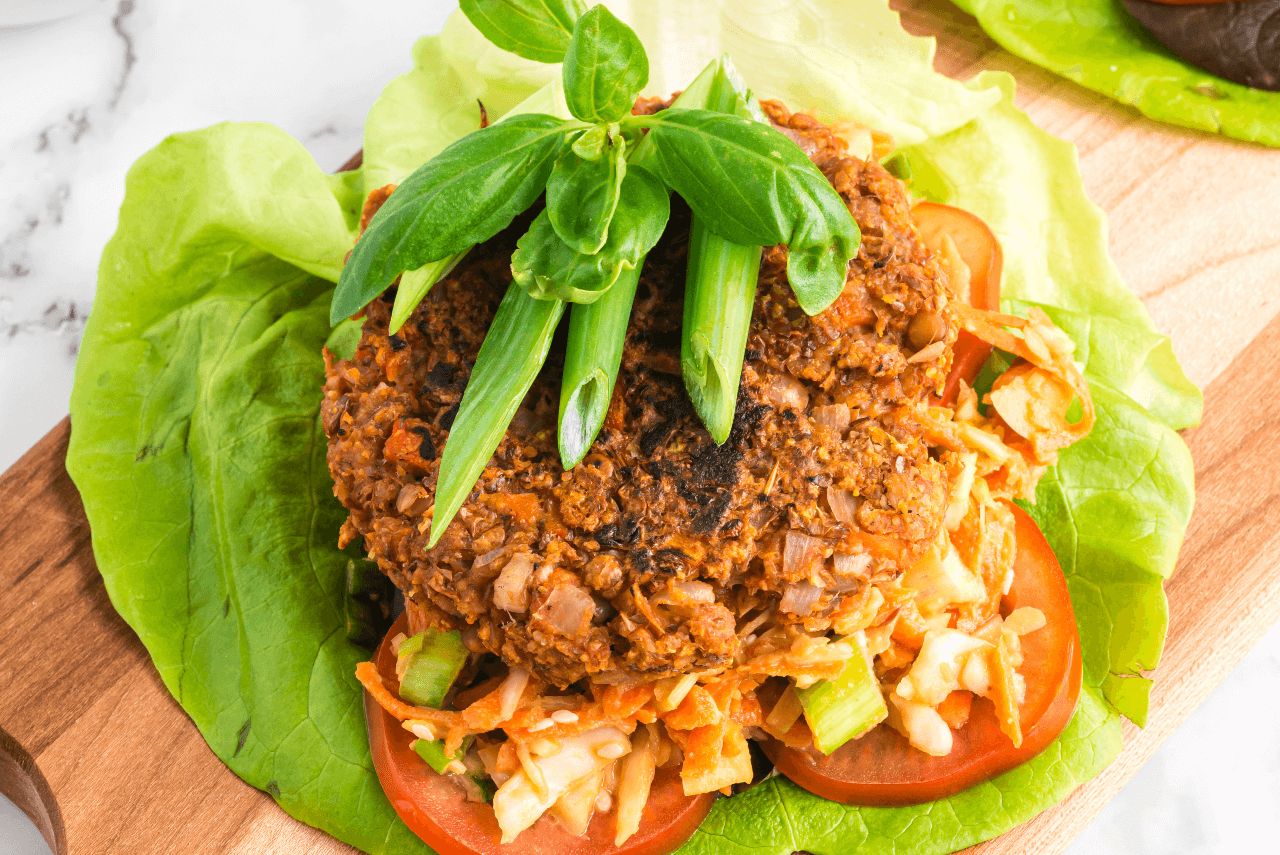
Make a large batch of veggie burgers and store it in your freezer. Enjoy the burgers solo as a fueling snack, or as part of a sandwich when you’re at home with the lights out and need to use up produce in the fridge and bread on the countertop. Layer the bread with lentil burgers, lettuce, tomatoes, onions, and any other veggies that need to be used ASAP.
Conclusion
Thinking about and preparing for possible emergencies may not top your need-to-do list (or your want-to-do list, for that matter). But, being ready with supplies and food could make the difference between weathering a storm (or another disaster) with relative ease and feeling like you’re at its absolute mercy. With some forethought, list-making, and emergency kit assembling, you can create a whole foods, plant-based shelter-in-place cache and go-bag that will help keep you well nourished and hydrated throughout the ordeal — and that knowledge should give you greater peace of mind, no matter what happens.
We are proud to announce a new partnership with John and Ocean Robbins and the Food Revolution to bring our readers Summits, Seminars and Masterclasses on health, nutrition and Earth-Conscious living.
Miss Your Chance to Attend for FREE!










